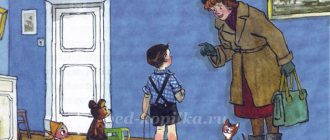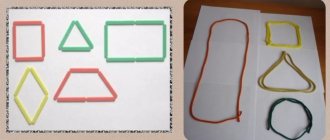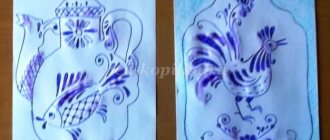Summary of the lesson “Time orientation” in the senior group of kindergarten
Lesson on FEMP at a preschool educational institution.
Senior group. Topic: Time orientation Program content : practice orientation on a sheet of paper; continue to teach asking questions using the words “how much”, “left”, “right”, “below”, “above”; practice counting within ten; in the name of the sequence of days of the week; develop attention and perseverance; fine motor skills of fingers; develop self-control skills. Demonstration material : cards for the game “Tangram”;
handouts: illustrations from the “Smart Book”; numbers up to seven; X. Cuisenaire's rods. Course of the lesson
1. Game “What is where?” You can use story pictures or toys. Children name where things are:
• A squirrel is sitting on a branch.
• Bunny under a bush. • Car behind the house. • Doll on the sofa. • Cube under the table. Etc. The teacher invites the children to ask each other what is on the right (left, above, below).
- Who is to the right of the tree?
- What's below? -What's up above the house? Etc. 2. Gymnastics for the eyes. Close eyes. Rest 10-15 s. Open eyes. Movements of the eyeballs: • eyes to the right - up; • eyes to the left - up; • eyes to the right - down; • eyes to the left - down. Close your eyes. Rest 10-15 s. 3. Game “Week, line up.” On the table there are upside-down cards with circles (or numbers) lying in disarray. Children, at a signal, take cards from the table and line up in order. Tasks: • children come out with cards with numbers indicating the days of the week after Thursday (children come out with the numbers five, six, seven); • a child comes out with a “Monday” card; • a child comes out with a card with the name of the day after Tuesday, and so on. 4. Game “Who knows, let him continue to count.” The teacher offers to count flowers (for example: tulips, dandelions, etc.). The teacher and children stand in a circle. The teacher says: “One dandelion” and throws the ball to the child, who catches the ball and continues: “Two dandelions,” throwing the ball to another child. And so on. Physical education lesson We will go right first - One, two, three. Now let's go left - One, two, three. And now we will all sit down - One, two, three. Let's stand up together and quietly - One, two, three. And now we will all dance - One, two, three. 5. Composition of numbers 6 and 7. Work with X. Cuisenaire sticks. The teacher reads a poem:
Number 1 - the very first snowball, 2 - a flower gently hung its head, 3 - the wind plays with the waves of the sea, 4 - the flag turns red (what color is it?), 5 - the color of the sun and dandelion, 6 - the colors of violets are more beautiful no, 7 - the soot in the chimney is getting blacker, 8 - ripe cherries have become tastier, 9 - fragile and pleasant like a bell, 10 - fresh and fragrant as an orange.
G. Popova Assignment: place a stick on the table that corresponds to the number 6 (purple). Children lay out the number six from other sticks (six white or yellow and white; two blue; three pink and so on). 6. Playing with sticks. On Monday - tangerine, And on Tuesday - orange, On Wednesday - chocolate, On Thursday - marmalade, On Friday - grapes, On Saturday - cookies, On Sunday - jam. I did the laundry on Monday, Paul swept on Tuesday. On Wednesday I baked a loaf of bread, I spent all Thursday looking for a ball, I washed the cups on Friday, and on Saturday I bought a cake. I invited all my girlfriends to my birthday party on Sunday. 7. Game "Tangram". Sample on the board:
Children assemble the square themselves. The one who collected it can compose the image according to his own design.
We recommend watching:
Summary of a lesson on FEMP in the senior group of kindergarten with a presentation. Composition of number 5 GCD for speech development in the senior group. A story on the topic “My favorite toy” Lesson notes for the senior group. Properties of paper Summary of GCD in the senior group on the topic: “Dandelion”
Similar articles:
Summary of a lesson in the senior group on the topic “Our Motherland – Russia”
Summary of a lesson in the senior group on the topic “Dishes”. Getting to know your surroundings
Abstract of GCD in the 2nd junior group: Time orientation
GCD in the second junior group on the topic “Orientation in time: day-night”
Author: Moiseeva Natalya Valentinovna, teacher of Gymnasium No. 1503 in Moscow (SP DO 1964)
Description: I offer an option for an activity with children aged 3-4 years, which in a playful way teaches children initial orientation in time, as we introduce the concept of day and night. Children of this age often confuse or do not define time concepts at all. The material will be useful to preschool teachers and parents. Goal: Leading children to understand time concepts. Objectives : Help children understand the features of day and night. Teach to distinguish between parts of the day: day and night. Expand children's understanding of the world around them, its objects and phenomena. Materials for the teacher: illustrative material - plot pictures depicting day and night.
GCD move
A bunny comes to visit the guys and tells them that something strange happened to him recently.
When he was returning home, it suddenly became dark outside and the bunny found a star. “Game with stars” Children are given stars cut out of cardboard. The teacher has a cloud in his hands. In accordance with the words of the poem, the children perform movements (first, the star children hide behind a cloud, then they show how the star is dozing, and at the end they shake their finger, showing that the star is mischievous). The game is based on the poem by M. Petrov A Little Star Hid Behind a Cloud. She dozed off in the sky with a faint light. The Naughty Girl probably didn’t sleep during the day. Reading the fairy tale “Day and Night” by Lyubov Voschenko Showing children pictures of “day and night”, discussing what happens when.
Game “Day-Night” Children stand in a circle, the teacher is in the middle of the circle. When the teacher says the word “day,” the children raise their hands up like rays of the sun, smile and repeat the word “day.” When the teacher says the word “night,” the children cover their faces with their palms and squat down, repeating the word “night.” The game is played 3 times. Children complete the task when something happens. The teacher asks riddles and receives a symbol for the answer. At the end of the game session, I offer the children templates of the sun and stars, which the children paste onto a canvas of the appropriate color (night-black, day-blue).
We recommend watching:
Game exercises for children 4 - 7 years old Synopsis of GCD for the 2nd junior group. Journey to the spring forest Didactic game for children 5-7 years old. Slovomania - C Summary of educational activities for children and parents of the senior group with a presentation on the topic: T
Similar articles:
Summary of lessons in kindergarten in the 2nd junior group. Doctor's profession
Summary of a lesson on social and communicative development in the junior group of kindergarten
Lesson notes about kindergarten. Junior group
Time orientation is important for the development of a child’s thinking. Already a baby learns day and night. This is the very first orientation in time since antiquity.
The baby is growing, and his ideas about time are expanding. To the concepts of “day” and “night” are added “morning” and “evening”. This time orientation is based on the activities of the child and his environment.
Time orientation game “Clock: time of day”
Option for 2-3 years.
Cut out a circle from cardboard. We paste 2 pictures on it. On one there is a sky with stars, on the other there is the sun in a blue sky. In the middle we drill a hole with a sharp object, through which we attach a cardboard arrow to the “clock”. We use a nut and bolt as fasteners. This is convenient because when you turn the arrows every day, the fasteners can become loose and the arrow will not stay in the desired position. Then you just need to tighten the nut.
Time of day orientation: how to play?
- Twice a day, change the position of the arrow, depending on the time of day, paying attention and telling the baby what is outside the window.
- Organize drawing day and night. It is better to paint with gouache, because gouache is a dense paint. If any flaws appear, it will be convenient to cover them up with this paint.
- Brushes: flat of different sizes. We will paint the sky with a wide brush. Show your child how to put paint on a brush, remove excess, and how to apply it to paper. Most often, children prefer to draw chaotically. Show the strokes from left to right.
- Now we need to wait until the first layer of our drawing dries. Kids are not able to wait long, so we speed up the process with the help of mom’s hairdryer. Paper: any material that absorbs well. Any in the sense that it is not necessary to buy some expensive paper. There will always be remnants of, for example, wallpaper in the house. Cut the size according to age and strength.
There are a number of paper placement options. The first one is on an easel. The second one is on the table. In any case, the sheet of paper must be fixed motionless.
- On the easel, the sheet is secured with clothespins on the top and sides or only on the sides.
- We fix the sheet on the table by the corners with adhesive tape.
- We dip a landscape sheet of paper into clean water, lift it vertically and wait for the water to drain. Wet paper will “stick” well to the table.
The placement option depends on the age and physical development of the baby. Please note that when painting on an easel, he will have to hold his hand and brush suspended, which not everyone can do. Modern children do not have good physical status.
A bucket of water and a rag are required. Emergency situations happen often - paint spills on the table, on the floor. It is important to wash gouache quickly.
An example of a time orientation lesson “Drawing a Day” for 2-3 years old.
- We fix the album sheet on the table (or easel).
- Let's dilute the blue and yellow gouache to the required degree. Pour the blue paint onto a saucer so that the brush can be dipped into the paint across its entire width. Pour yellow paint into the cell of the palette.
- With a wide flat brush, the child paints a sheet of paper - “sky”.
- Dry the drawing with a hairdryer. Do not bring it close so that the paint does not splatter.
- When the “sky” dries, draw a yellow circle on it with a narrow flat brush. You can paint it over or leave it as is. This is the sun.
- All that remains is to draw rays from the sun and dry the picture with a hairdryer.
If the paper is deformed, iron the design on the reverse side. The finished drawing can be glued to a “watch” for orientation in time, placed in a plastic file, framed and placed on the wall. We draw the night in the same way. Here is the simplest orientation in time. Even the most restless child will be happy to look at his own drawings.
0
TIME ORIENTATION FOR PRESCHOOL CHILDREN
TIME ORIENTATION FOR PRESCHOOL CHILDREN
Content
1. Psychological foundations of time perception by preschool children
2. Contents of work on the development of time concepts in children in preschool educational institutions
3. Methodology of work on the formation of temporary representations in children in classes on mathematical development
Bibliography
1. Psychological foundations of time perception by preschool children
A person faces the problem of time every day, tearing off a piece of the calendar, every minute, looking at his watch. A child also lives in time, so the education and training program in kindergarten provides for the development of time orientation in children. The introduction of this section is due to a number of reasons. Children are introduced to the world around them, in which all events take place in time. The temporal characteristics of real phenomena, their duration, the order in which they follow each other, the speed of occurrence, the frequency of repetitions and rhythm must be shown and explained to preschoolers.
Already at preschool age, it is vitally important for children to learn how to navigate time themselves: to determine, measure time (correctly denoting it in speech), feel its duration (in order to regulate and plan activities in time), change the pace and rhythm of their actions depending on the availability of time. The ability to regulate and plan activities over time creates the basis for the development of such personality qualities as organization, composure, focus, precision, which are necessary for a child when studying at school and in everyday life.
At the same time, the specific features of time as an objective reality make it difficult for children to perceive it. Time is always in motion, the flow of time always occurs in one direction - from the past to the future, it is irreversible, it cannot be delayed, returned and “showed”. Therefore, even older preschoolers sometimes doubt the existence of time and ask: “If there is time, show it to me.”
How can a child show the time?
Time is perceived by the child indirectly, through the concretization of temporary units and relationships in constantly recurring phenomena of life and activity. Children's ideas about such periods of time, the skill of distinguishing which is formed on the basis of personal experience, are more accurate. Therefore, children need to be introduced to such time intervals that can be used to measure and determine the duration, sequence, and rhythm of their actions and various types of activities.
All measures of time (minute, hour, day, week, month, year) represent a certain system of time standards, where each measure is added up from the units of the previous one and serves as the basis for constructing the next one. Therefore, children’s acquaintance with units of time measurement should be carried out in a strict system and sequence, where knowledge of some time intervals, the ability to define and measure them, would serve as the basis for familiarization with the following and reveal to children the essential characteristics of time: its fluidity, continuity, irreversibility. In the process of various types of activities, children are exposed to a very complex set of stimuli, in which temporary relationships are only a weak and incidental component. According to the teachings of I.P. Pavlova, although a weak stimulus participates in the formation of temporary connections in a hidden form, taken separately, it does not cause a subsequent reaction. Therefore, time and the alternation of its specific segments must be made the subject of special attention for children, for which it is necessary to organize appropriate activities aimed at measuring time using instruments that demonstrate certain periods of time and their interrelationships. Such activities create the most favorable conditions for the formation of clear ideas about time.





